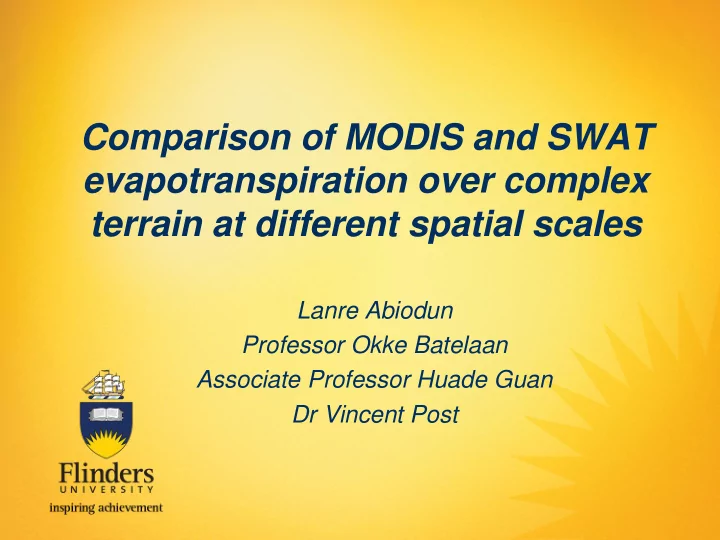

Comparison of MODIS and SWAT evapotranspiration over complex terrain at different spatial scales Lanre Abiodun Professor Okke Batelaan Associate Professor Huade Guan Dr Vincent Post
ET Facts • ET is difficult to measure accurately • Two principal methods of ET estimation – Ground based and models • Current ground based ET methods are expensive and offer poor catchment/ regional scale estimates
This Study • Two models – Hydrological (SWAT) and Energy balance based model (MOD16) in a complex terrain • We analyse the results to determine spatio-temporal correlations • Determine the drivers of ET in the models
Study Area • The Sixth Creek Catchment of the Western Mount Lofty Ranges (44 km 2 ) • Complex rolling terrain with highly varied rainfall events Geoscience Australia (2015)
Methodology • Create a catchment hydrological model for the Sixth Creek in SWAT • Extract the residual simulated ET and process into monthly 1km 2 grids • The SWAT ET were analysed alongside publically available MOD16 data from NASA
Stream flow validation results (2007 – 2013) Metric Value NSE 0.78 R 2 0.78 Pbias 6.3 KGE 0.86
ET Catchment Scale (2007 -2013) Metric Mm/month RMSE 16.5 R 2 0.82 CORREL 0.90 MD 0.78
Spatio-temporal Comparison SWAT & MOD16 SPATIAL ET AVERAGE (2007 – 2013)
Spatial Analysis SWAT ET – MOD16 ET (Cells aggregation mean 2007- 2013)
Findings • The two products were within 8% of each other on catchment scale annually • Up to 56%, 16% and 6% differences at 1km 2 , 4km 2 and 16km 2 spatial resolutions • Biome mismatch were responsible for poor correlation in specific areas
Findings • Catchment scale averaging of input climate data in SWAT affected correlation at higher resolution • The models agreed reasonably well regardless of the complex terrain • The study suggests groundwater ET may be a significant catchment process
Conclusion • The results suggest that ET models can be reasonably reliable at the 4 km 2 spatial resolution • Fine spatial resolution ET products (1 km 2 and below) should be used in studies with discretion
Further Study • Eddy Covariance (EC) Method vs Maximum Entropy Production (MEP) Method
Recommend
More recommend